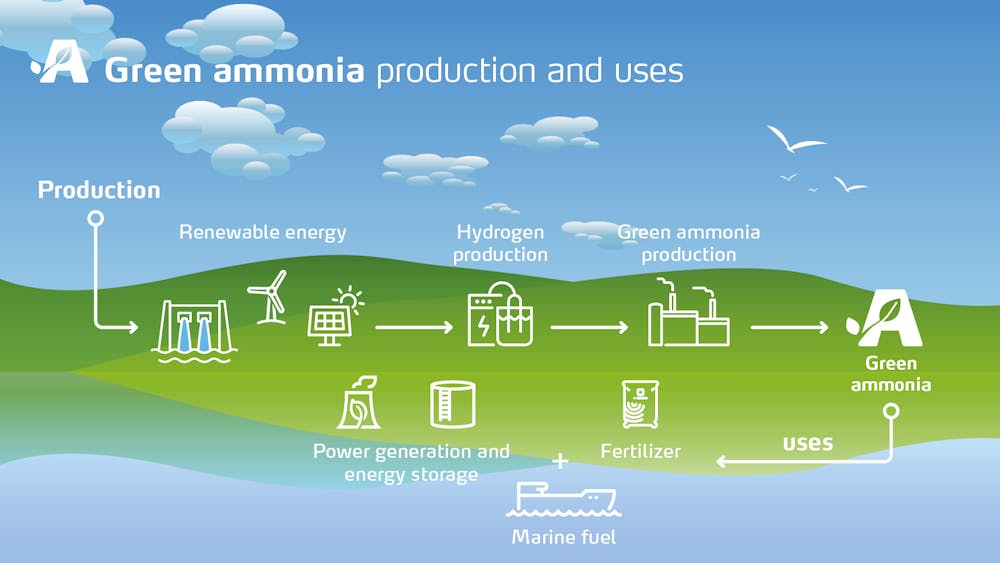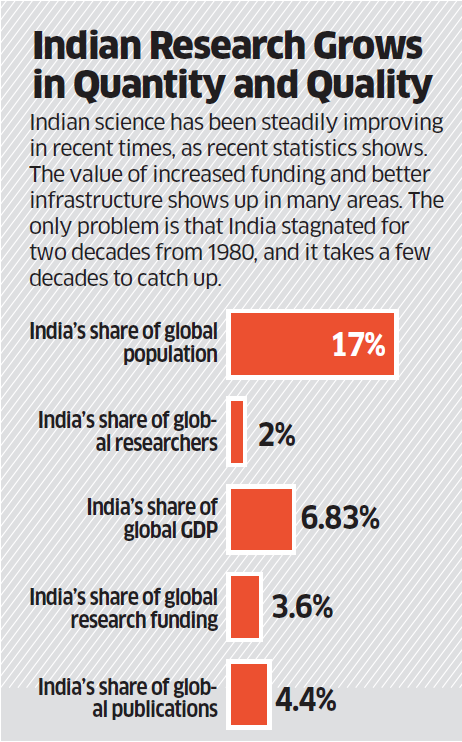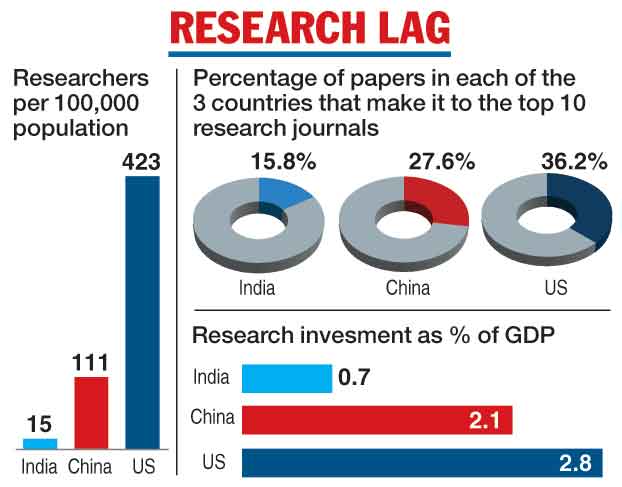|
|
||
|
28 February 2024 |
||
|
- The Global Race for Green Ammonia Production
- India’s First Indigenous Space Mission
- Sustainable funding for India’s ‘Science Power’ ambition
- The Dr. T.K. Vishwanathan committee
- Similipal Tiger Reserve (STR)
- National Science Day

- The Global Race for Green Ammonia Production
Introduction
In the pursuit of sustainable agriculture and energy solutions, there has been a surge in innovative efforts globally to produce environmentally friendly ammonia.

Understanding Green Ammonia
- Green ammonia, also referred to as renewable ammonia, is produced through a process that begins with obtaining green hydrogen via water electrolysis.
- This process involves decomposing water into hydrogen and oxygen using electrical energy derived from renewable sources.
- Subsequently, the hydrogen is reacted with atmospheric nitrogen through the Haber-Bosch synthesis method, where they combine under high pressure and temperature in the presence of a catalyst to form ammonia.
- The outcome is the creation of green ammonia, utilizing green hydrogen and atmospheric nitrogen.
Applications of Green Ammonia
- Fertilizer: Ammonia is a key component of nitrogen-based fertilizers. Green ammonia can be used as an eco-friendly alternative to conventional ammonia-based fertilizers. It provides essential nutrients to plants and promotes healthy growth.
- Energy Storage: Green ammonia can serve as a hydrogen carrier for energy storage. It can be synthesized using excess renewable energy (such as wind or solar power) and stored for later use. When needed, it can be converted back to hydrogen for electricity generation or other applications.
- Fuel: Green ammonia can be used as a clean fuel for various purposes:
- Transportation: It can power fuel cells in vehicles, ships, and airplanes.
- Power Generation: Ammonia can be burned directly in gas turbines or used in combined-cycle power plants.
- Heating and Cooking: It can replace natural gas for heating and cooking.
- Chemical Industry: Green ammonia serves as a precursor for various chemicals and materials:
- Hydrogen Production: It can be split into hydrogen and nitrogen, providing a sustainable source of hydrogen.
- Urea Production: Urea, a common fertilizer, is synthesized from ammonia.
- Plastics and Polymers: Ammonia is used in the production of plastics and synthetic fibers.
- Coolant and Refrigerant: Ammonia has excellent thermodynamic properties and is used as a refrigerant in industrial cooling systems and air conditioning units.
- Cleaning Agents: Ammonia-based cleaning products can be made using green ammonia. They are effective for removing stains, grease, and dirt.
- Green ammonia finds various applications, including its use in agricultural fertilizers and as a raw material in the production of diverse chemical products like nitric acid, synthetic fibers, explosives, dyes, and pharmaceuticals.
- Additionally, there are potential uses for green ammonia as a fuel for ships, boilers, turbines, or engines to generate heat and electricity.
Contrasting Green and Grey Ammonia
Contrasting with green ammonia, which is produced using renewable energy sources, grey ammonia is formed through a conventional process that emits significant amounts of CO2 during production.
Challenges in Green Ammonia Production
- One of the significant challenges associated with green ammonia production is its high cost compared to conventional brown ammonia, primarily due to the expenses involved in electrolysers and green power.
- Additionally, storage of hydrogen, obtained through water electrolysis, poses logistical challenges, leading to disruptions in the continuous supply of feedstock to ammonia plants.
Opportunities for India
- However, the transition to green ammonia presents an opportunity for India, given its substantial existing non-fossil-fuel capacity, with a significant portion derived from renewable sources.
- India aims to further expand its renewable capacity, targeting 500 GW by 2030, which aligns with the growing demand for fertilizers and ammonia in the country.
- By establishing approximately 5.8 million tonnes of green ammonia manufacturing capacity across various regions, India can significantly reduce its carbon footprint while meeting the escalating demand for ammonia.
- India’s First Indigenous Space Mission

Context: In recent news, the Prime Minister of India announced the selection of astronauts for the country’s first crewed space mission, Gaganyaan, scheduled for launch in 2025.
About Gaganyaan Mission
- The Gaganyaan Mission aims to demonstrate India’s capability in human spaceflight by sending a crew of four into a Low Earth Orbit of 400 km.
- It seeks to showcase India’s indigenous capacity for manned space missions.
Launch Vehicle: GSLV Mk III
The GSLV Mk III, also known as LVM-3, will serve as the launch vehicle for the Gaganyaan mission.

Technological Requirements
- Key technological components include a human-rated LVM3, equipped with a Crew Escape System and an Orbital Module to ensure crew safety.
- The Orbital Module provides habitable space for the crew, while the Service Module supports the crew module in orbit.
Phases of Gaganyaan Mission
- The mission comprises several phases, including testing, unmanned missions for technology demonstration, and finally, a manned mission.
- Notably, Vyommitra AI humanoid underwent tests for the unmanned missions.
Significance of the Mission
The significance of the mission lies in technological advancement, inspiring youth towards careers in science and technology, fostering diplomatic collaboration, enabling scientific breakthroughs, and contributing to economic growth.
Challenges Associated
Challenges associated with the mission include reliance on indigenous technology, development of customized launch vehicles, training and simulation needs, creating regenerative environments, and ensuring crew safety.
Conclusion
The Gaganyaan Mission represents India’s leap towards space exploration, embodying aspirations of scientific discovery, technological innovation, and international collaboration.
Despite challenges, India is poised to make significant strides in its space endeavors, inspiring future generations and advancing towards the frontiers of the cosmos.

- Sustainable funding for India’s ‘Science Power’ ambition

Sustainable Funding for Science
National Science Day: The article begins by mentioning National Science Day, which is focused on ‘Science for Sustainable Development’ and highlights the importance of sustainable funding for science that drives India’s journey towards becoming a developed country by 2047.
Status of R&D Expenditure in India
- Investment Trends: There’s been a declining trend in India’s research and development (R&D) expenditure as a percentage of GDP, from 0.8% in 2004-05 to 0.7% in 2017-2018.
- Sector-wise Contribution: The private sector contributes less to R&D compared to the central sector, as shown in the charts.

Budget and Management of Funds
- Underutilisation of Budget: The Ministry of Science and Technology has consistently under-utilized its budget. The Department of Science and Technology (DST) receives the lowest allocation for its operational schemes, at only 6%.
- Allocation Issues: The article suggests that there is a need for a comprehensive budget that includes both government and private contributions.
Challenges and Proposals
- Effective Utilization: The piece outlines the need for better strategies to utilize the allocated R&D budget.
- Policy Recommendations: It calls for policy reform, such as improving the bureaucratic processes for approvals, prioritizing science, and increasing the utilization of allocated funds.

Vision for the Future
Goal for 2047: To reach a developed nation status, the article suggests India needs to scale up its R&D expenditure to at least 3% of the GDP by 2047.
- Private Sector Engagement: The latest Budget emphasizes the need for private sector contributions to R&D funding.
Sustainable Funding Definition and Importance
- Meaning of Sustainable Funding: The article defines sustainable funding as having a budget that is not only consistent but also strategically allocated.
- Finance Minister’s Statement: The Finance Minister, Nirmala Sitharaman, indicated the government’s wish for more private sector contributions in R&D.

Expert Opinion
Shambhavi Naik’s Insight: The article includes insights from Shambhavi Naik, a researcher at The Takshashila Institution, highlighting the need for a more comprehensive approach to funding and policy for sustainable science development.
- The Dr. T.K. Vishwanathan committee
https://www.livemint.com/politics/policy/expert-committee-submits-final-report-on-arbitration-reforms-11707937675777.html
Establishment of Arbitration Division in High Courts
Efficient resolution of corporate disputes can be achieved by establishing a dedicated Arbitration Division within each High Court.
Timely Proceedings and Decisions
The Arbitration Division would conduct proceedings promptly and deliver timely decisions, ensuring swift resolution of disputes.
Enforcement Process
- The enforcing Court should handle petitions within a nine-month timeframe, except in cases where enforcement is stayed.
- Adjournments during proceedings should be granted sparingly, only under exceptional circumstances.
Model Procedure
A model procedure based on established best practices has been proposed, providing a useful reference for arbitral tribunals.
Court Oversight
While court oversight is necessary to uphold the legitimacy and integrity of arbitration, its involvement should be limited to overall supervision and a review of awards at the post-award stage.
Institutionalization of Arbitrator Appointment Process
Efforts should be made to institutionalize the arbitrator appointment process and reduce court intervention during the initial stages.
Flexible Fee Structures
The committee recommends revising arbitrators’ fees periodically, with different fee structures for small and medium value claims, to accommodate changing circumstances without requiring amendments to the law.
Challenges to Arbitral Awards
Challenges to arbitral awards should be based on a realistic assessment of success prospects versus litigation costs.
Legal Justification for Challenges
Legal professionals responsible for arbitration should justify their challenges and seek senior legal counsel when necessary.
Standing Committee for Award Reviews
A standing committee could be appointed to promptly review awards and determine whether to challenge or settle them.
Regular Reviews of Arbitral Awards
Regular reviews of arbitral awards should be conducted to prevent challenges from expiring.
Consideration of Separate Legislation for Domestic Disputes
Considering the differences between domestic and international arbitration, it is suggested to explore the possibility of enacting separate legislation for domestic disputes.
- Similipal Tiger Reserve (STR)
Concerns over Pseudo-Melanism in Similipal Tiger Reserve (STR)
- Recent reports have brought attention to the significant number of pseudo-melanistic tigers in the Similipal Tiger Reserve (STR) in Odisha.
- This phenomenon is largely attributed to inbreeding among the tiger population.
- In response, the Odisha government has reached out to the National Tiger Conservation Authority (NTCA), proposing the introduction of female tigers from other regions to diversify the gene pool in the reserve.

Overview of Similipal Tiger Reserve (STR)
- Location and Size: Located in Odisha’s Mayurbhanj District, covers an area of 2750 sq km.
- Geography: Characterized by high plateaus and hills, including peaks like Khairiburu and Meghashini, which reach heights of 1515 m.
- History: Established as a hunting ground, designated as a tiger reserve under Project Tiger in 1973, later declared a wildlife sanctuary and biosphere reserve.
Biodiversity of Similipal Tiger Reserve (STR)
- Flora and Fauna: Rich biodiversity includes tigers, leopards, elephants, gaur, various bird species, King cobras, orchids, and medicinal plants.
- Indigenous Tribes: Home to indigenous tribes like the Kolha, who practice traditional conservation methods.
- UNESCO Recognition: Listed as a Biosphere Reserve in May 2009 due to its ecological significance.
Recent Events and Conservation Challenges
- In recent years, Similipal has faced conservation challenges, including a significant fire in 2021 that threatened its biodiversity.
- Despite these challenges, the reserve has received global recognition and is part of the Global Network of Biospheres since 2009.
Understanding Melanism in Similipal Tiger Reserve (STR)
- Genetic Anomaly: Pseudo-melanism, a genetic condition, results in elevated melanin levels and distinctive striped patterns on the coats of tigers.
- Genetic Mutation: Research indicates a single mutation in the Transmembrane Aminopeptidase Q (Taqpep) gene is responsible for pseudo-melanism in Similipal’s tigers.
- Inbreeding and Isolation: Genetic analyses suggest inbreeding due to isolation from other tiger populations may have contributed to the prevalence of pseudo-melanism among Similipal’s tigers.
Population Dynamics and Conservation Efforts
- High Frequency: Approximately 37% of the tiger population in Similipal exhibits pseudo-melanism, highlighting the significance of this unique phenotype.
- Conservation Measures: Odisha plans to establish a melanistic tiger safari near the reserve to raise awareness about tiger conservation and provide visitors with an opportunity to observe these animals up close.

- National Science Day

Context:
In India, National Science Day is celebrated annually on February 28th to commemorate the discovery of the Raman Effect by the Indian scientist and physician Chandrasekhara Venkata Raman.
Aims of National Science Day
National Science Day serves to raise awareness about the impact of science on daily life and to highlight the achievements of Indian scientists.
Origin of National Science Day
- The idea of observing February 28th as National Science Day was put forward by the National Council for Science and Technology Communication (NCSTC) in 1986 and was subsequently endorsed by the Government of India.
- The inaugural National Science Day was held on February 28th, 1987.
Theme for 2024
The theme for the 2024 National Science Day is “Indigenous Technology for Viksit Bharat.”
The Raman Effect: A Groundbreaking Discovery
- Sir CV Raman’s groundbreaking discovery in 1928 led to the unveiling of the Raman Effect, which is a physical phenomenon that occurs when light interacts with matter and alters its wavelength.
Understanding the Raman Effect
- This effect involves the scattering of light by molecules of gases, liquids, or solids.
- It occurs due to a change in the wavelength of light when it is deflected by molecules, resulting in weaker Raman lines in the scattered light.

Significance of the Raman Effect
Sir CV Raman’s discovery not only earned him the Nobel Prize in Physics in 1930 but also paved the way for advancements in various scientific fields.



